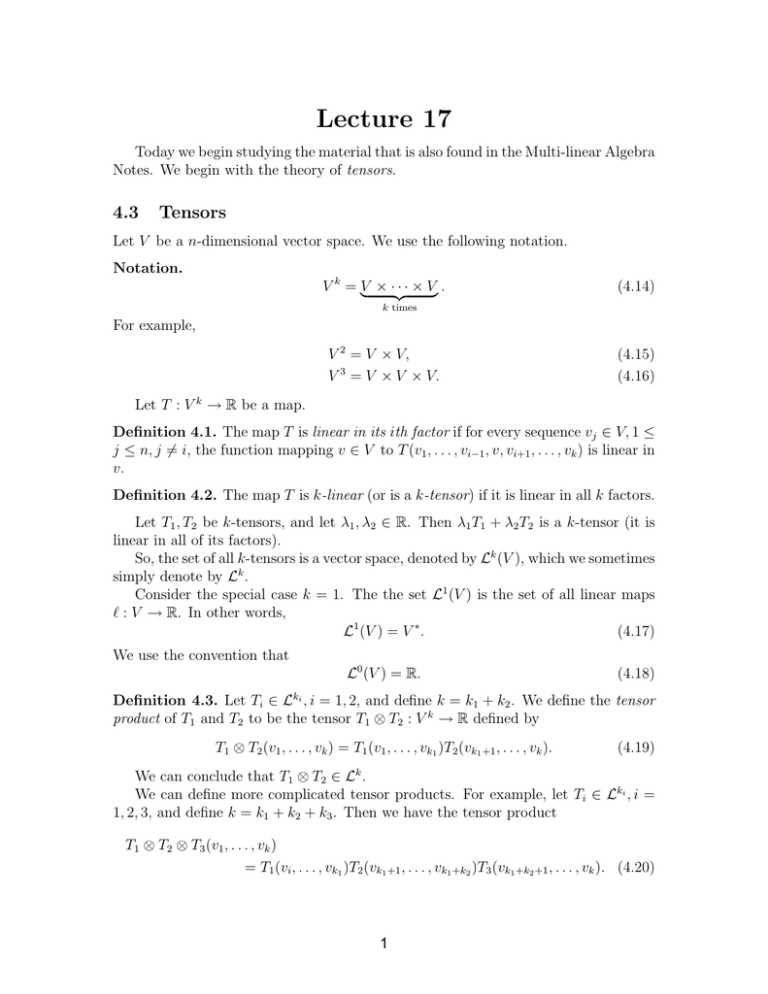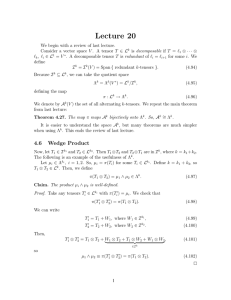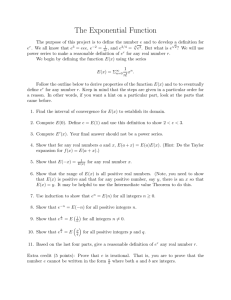Document 13570050
advertisement

Lecture 17
Today we begin studying the material that is also found in the Multi­linear Algebra
Notes. We begin with the theory of tensors.
4.3
Tensors
Let V be a n­dimensional vector space. We use the following notation.
Notation.
Vk =V
· · × V� .
� × ·��
(4.14)
V 2 = V × V,
V 3 = V × V × V.
(4.15)
(4.16)
k times
For example,
Let T : V k → R be a map.
Definition 4.1. The map T is linear in its ith factor if for every sequence vj ∈ V, 1 ≤
j ≤ n, j �= i, the function mapping v ∈ V to T (v1 , . . . , vi−1 , v, vi+1 , . . . , vk ) is linear in
v.
Definition 4.2. The map T is k­linear (or is a k­tensor) if it is linear in all k factors.
Let T1 , T2 be k­tensors, and let λ1 , λ2 ∈ R. Then λ1 T1 + λ2 T2 is a k­tensor (it is
linear in all of its factors).
So, the set of all k­tensors is a vector space, denoted by Lk (V ), which we sometimes
simply denote by Lk .
Consider the special case k = 1. The the set L1 (V ) is the set of all linear maps
� : V → R. In other words,
L1 (V ) = V ∗ .
(4.17)
We use the convention that
L0 (V ) = R.
(4.18)
Definition 4.3. Let Ti ∈ Lki , i = 1, 2, and define k = k1 + k2 . We define the tensor
product of T1 and T2 to be the tensor T1 ⊗ T2 : V k → R defined by
T1 ⊗ T2 (v1 , . . . , vk ) = T1 (v1 , . . . , vk1 )T2 (vk1 +1 , . . . , vk ).
(4.19)
We can conclude that T1 ⊗ T2 ∈ Lk .
We can define more complicated tensor products. For example, let Ti ∈ Lki , i =
1, 2, 3, and define k = k1 + k2 + k3 . Then we have the tensor product
T1 ⊗ T2 ⊗ T3 (v1 , . . . , vk )
= T1 (vi , . . . , vk1 )T2 (vk1 +1 , . . . , vk1 +k2 )T3 (vk1 +k2 +1 , . . . , vk ). (4.20)
1
Then T1 ⊗ T2 ⊗ T3 ∈ Lk . Note that we could have simply defined
T1 ⊗ T2 ⊗ T3 = (T1 ⊗ T2 ) ⊗ T3
= T1 ⊗ (T2 ⊗ T3 ),
(4.21)
where the second equality is the associative law for tensors. There are other laws,
which we list here.
• Associative Law: (T1 ⊗ T2 ) ⊗ T3 = T1 ⊗ (T2 ⊗ T3 ).
• Right and Left Distributive Laws: Suppose Ti ∈ Lki , i = 1, 2, 3, and assume
that k1 = k2 . Then
– Left: (T1 + T2 ) ⊗ T3 = T1 ⊗ T3 + T2 ⊗ T3 .
– Right: T3 ⊗ (T1 + T2 ) = T3 ⊗ T1 + T3 ⊗ T2 .
• Let λ be a scalar. Then
λ(T1 ⊗ T2 ) = (λT1 ) ⊗ T2 = T1 ⊗ (λT2 ).
(4.22)
Now we look at an important class of k­tensors. Remember that L1 (V ) = V ∗ ,
and take any 1­tensors �i ∈ V ∗ , i = 1, . . . , k.
Definition 4.4. The tensor T = �1 ⊗ · · · ⊗ �k is a decomposable k­tensor.
By definition, T (v1 , . . . , vk ) = �1 (v1 ) . . . �k (vk ). That is, �1 ⊗ · · · ⊗ �k (v1 , . . . , vk ) =
�1 (v1 ) . . . �k (vk ).
Now let us go back to considering Lk = Lk (V ).
Theorem 4.5.
dim Lk = nk .
(4.23)
Note that for k = 1, this shows that L1 (V ) = V ∗ has dimension n.
Proof. Fix a basis e1 , . . . , en of V . This defines a dual basis e∗i , . . . , e∗n of V ∗ , e∗i : V →
R defined by
�
1 if i = j,
e∗i (ej ) =
(4.24)
0 if i =
� j.
Definition 4.6. A multi­index I of length k is a set of integers (i1 , . . . , ik ), 1 ≤ ir ≤ n.
We define
(4.25)
e∗I = e∗i1 ⊗ · · · ⊗ e∗ik ∈ L
k .
Let J = (j1 , . . . , jk ) be a multi­index of length k. Then
�
1 if I = J,
∗
∗
∗
eI (ej1 , . . . , ejk ) = ei1 (ej1 ) . . . eik (ejk ) =
0 if I =
� J.
2
(4.26)
Claim. The k­tensors e∗I are a basis of Lk .
Proof. To prove the claim, we use the following lemma.
Lemma 4.7. Let T be a k­tensor. Suppose that T (ei1 , . . . , eik ) = 0 for all multi­
indices I. Then T = 0.
Proof. Define a (k − 1)­tensor Ti : V k−1 → R by setting
Ti (v1 , . . . , vk−1 ) = T (v1 , . . . , vk−1 , ej ),
(4.27)
�
�
and let vk =
ai ei . By linearity, T (v1 , . . . , vk ) =
ai Ti (v1 , . . . , vk−1 ). So, if the
lemma is true for the Ti ’s, then it is true for T by an induction argument (we leave
this to the student to prove).
With this lemma we can prove the claim.
First we show that the e∗I ’s are linearly independent. Suppose that
�
0=T =
cI e∗I .
(4.28)
For any multi­index J of length k,
0 = T (ej1 , . . . , ejk )
�
=
cI e∗I (ej1 , . . . , ejk )
(4.29)
= cJ
= 0.
So the e∗I ’s are linearly independent.
Now we show that the�e∗I ’s span Lk . Let T ∈ Lk . For every I let TI =
T (ei1 , . . . , eil ), and let T � = TI e∗I . One can check that (T − T � )(ej1 , . . . , ejk ) = 0 for
all multi­indices J. Then the lemma tells us that T = T � , so the e∗I ’s span Lk , which
proves our claim.
Since the e∗I ’s are a basis of Lk , we see that
dim Lk = nk ,
which proves our theorem.
3
(4.30)
4.4
Pullback Operators
Let V, W be vector spacers, and let A : V → W be a linear map. Let T ∈ Lk (W ),
and define a new map A∗ T ∈ Lk (V ) (called the “pullback” tensor) by
A∗ T (v1 , . . . , vk ) = T (Av1 , . . . , Avk ).
(4.31)
You should prove the following claims as an exercise:
Claim. The map A∗ : Lk (W ) → Lk (V ) is a linear map.
Claim. Let Ti ∈ Lki (W ), i = 1, 2. Then
A∗ (T1 ⊗ T2 ) = A∗ T1 ⊗ A∗ T2 .
(4.32)
Now, let A : V → W and B : W → U be maps, where U is a vector space. Given
T ∈ Lk (U ), we can “pullback” to W by B ∗ T , and then we can “pullback” to V by
A∗ (B ∗ T ) = (B ◦ A)∗ T .
4.5
Alternating Tensors
In this course we will be restricting ourselves to alternating tensors.
Definition 4.8. A permutation of order k is a bijective map
σ : {1, . . . , k} → {1, . . . , k}.
(4.33)
The map is a bijection, so σ −1 exists.
Given two permutations σ1 , σ2 , we can construct the composite permutation
σ1 ◦ σ2 (i) = σ1 (σ2 (i)).
(4.34)
Sk ≡ The set of all permutations of {1, . . . , k}.
(4.35)
We define
There are some special permutations. Fix 1 ≤ i < j ≤ k. Let τ be the permutation
such that
τ (i) = j
τ (j) = i
τ (�) = �, � =
� i, j.
(4.36)
(4.37)
(4.38)
The permutation τ is called a transposition.
Definition 4.9. The permutation τ is an elementary transposition if j = i + 1.
We state without proof two very useful theorems.
4
Theorem 4.10. Every permutation can be written as a product σ = τ1 ◦ τ2 ◦ · · · ◦ τm ,
where each τi is an elementary transposition.
Theorem 4.11. Every permutation σ can be written either as a product of an even
number of elementary transpositions or as a product of an odd number of elementary
transpositions, but not both.
Because of the second theorem, we can define an important invariant of a permu­
tation: the sign of the permutation.
Definition 4.12. If σ = τ1 ◦ · · · ◦ τm , where the τi ’s are elementary transpositions,
then the sign of σ is
sign of σ = (−1)σ = (−1)m .
(4.39)
Note that if σ = σ1 ◦ σ2 , then (−1)σ = (−1)σ1 (−1)σ2 . We can see this by letting
�
σ1 = τ1 ◦ · · · ◦ τm1 , and σ2 = τ1� ◦ · · · ◦ τm
, and noting that σ1 ◦ σ2 = τ1 ◦ · · · ◦ τm1 ◦
2
�
�
τ1 ◦ · · · ◦ τm2 .
5







